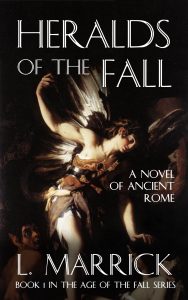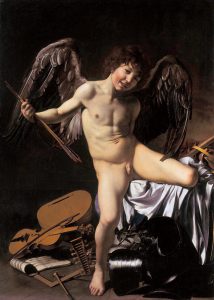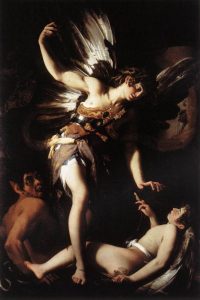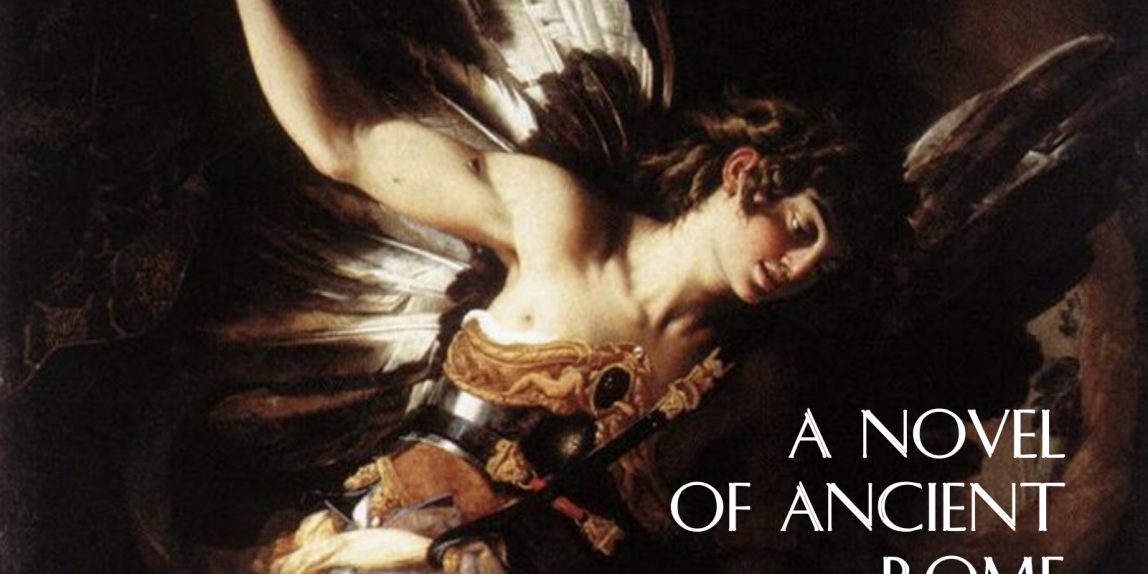
Caravaggio was a brilliant painter and a hot-tempered brawler.
From humble beginnings (he’s said to have fled Milan after fighting and attacking a police officer, and to have wandered into Rome naked and penniless), he developed a reputation as a skilled, dramatically talented artist.
That was in no small part due to his eye-catching style, which used striking contrasts of light and shadow to illuminate his subjects, who were often in the middle of some violent act. Caravaggio’s style caught on. For several centuries. Today, we call it chiaroscuro, tenebrism, or dramatic illumination.
But all that came later.
At the time, he was just kicking ass and painting people in Rome. (Literally, Caravaggio still liked to brawl.)
So Caravaggio’s popularity grew, and eventually the rich son of a banking family commissioned him to create a painting. This was the Renaissance, and rich people liked to commission paintings and stuff.
Caravaggio painted the famous Amor Vincet Omnia.
Here it is:

Just look at that cherubic little fucker triumphing over all the works of mankind—the trappings of music, writing, architecture, astronomy, and war are all strewn around his feet. He’s basically trampling them.
This little guy represents love.
(Side note: In Renaissance Rome it would’ve been pretty common to see naked kids running around and playing in the Tiber. The nudity in the painting probably represented innocence more than sexuality.)
Or, some said, the painting represented the rich banker guy who commissioned it, since the letter “V” is clearly visible on the music on the ground, and that was the banker’s initial.
I think it’s reasonable to assume the banker was pleased with his commission.
But the banker guy’s brother gets a look at this painting and goes, “Really? Psshhh. I can totally commission a painting to kick your painting’s ass.”
And the brother hires an artist named Giovanni Baglione to paint his OWN damn commission.
In a royal Renaissance F-U, Baglione paints a fiercely beautiful avenging angel swooping down to destroy the little cherub guy, along with a dark figure the cherub was “meeting” with. (Ahem, interpret that however your wicked little mind sees fit, Nancy.) He called his masterpiece: Sacred Love and Profane Love. (Sacred Love is the avenging angel, and Profane Love is the little naked guy.)
Here it is:

This was probably a Renaissance version of two snobby brothers trying to one-up one another. It was probably all in good fun for them. (At least, this is what my admittedly surface-level research on this topic has revealed to me.)
But Caravaggio, inveterate fighter and inventor of chiaroscuro, got a look at Baglione’s dramatic illumination painting, and was like “Aw, hell naw, bitch that is MY style!”
(I gotta say, he was right. I actually thought this painting was by Caravaggio until I looked into it more deeply.)
Caravaggio accused Baglione of plagiarism. And started talking all kinds of shit about him all over Rome and Italy.
In response, Baglione painted another version of his masterpiece. But this time, he made the avenging angel a lot sexier and gave the dark figure a devil-like face that looked remarkably like Caravaggio himself:

Troll level 100.
And now, many years later, that contentious piece is in the public domain and on the cover of my book. I suspect the two artists would both like to create pieces to give me the proverbial artistic finger for using this work as part of my own. It’s tradition.
I hope you have enjoyed this pocket lesson in Renaissance art rivalries.
— L.
